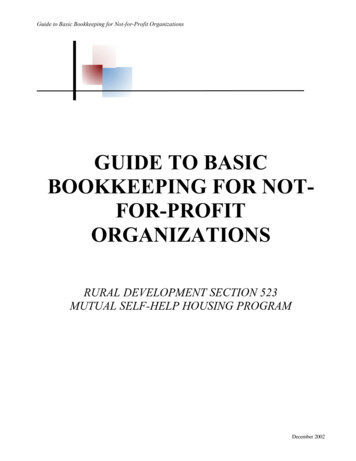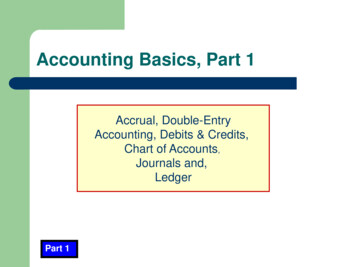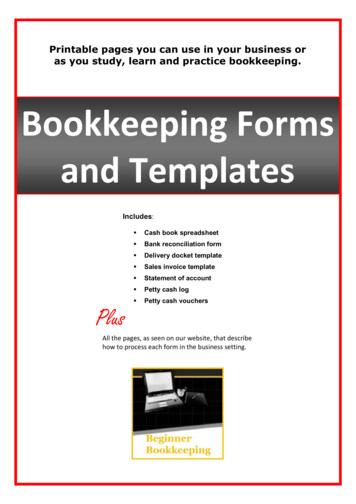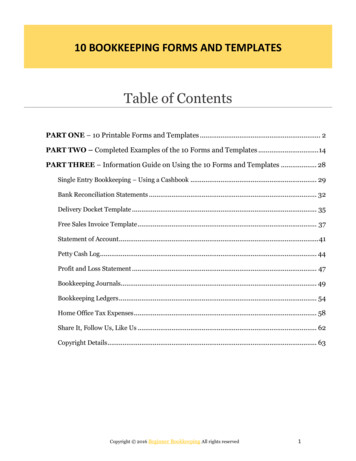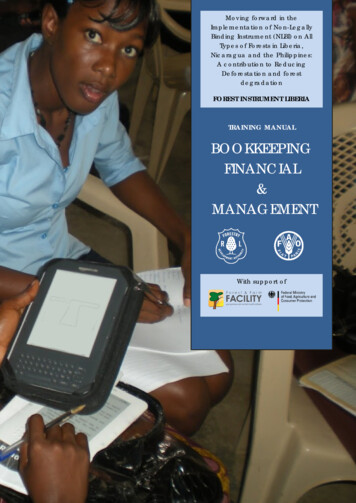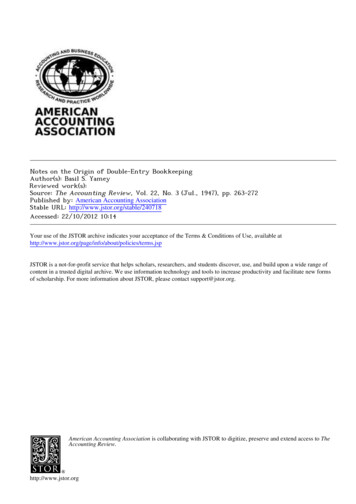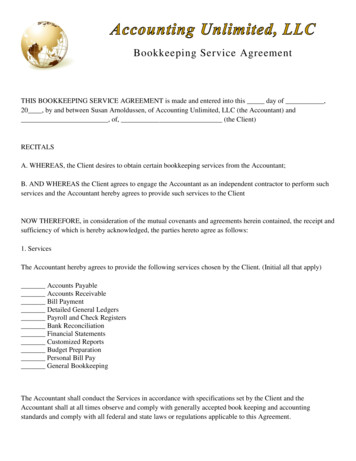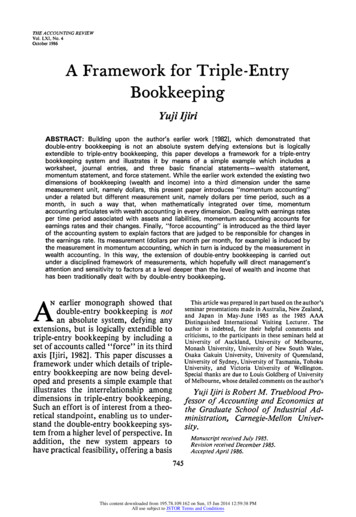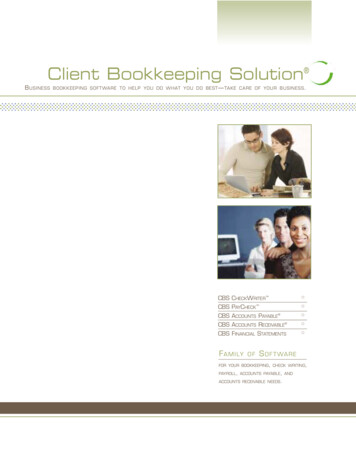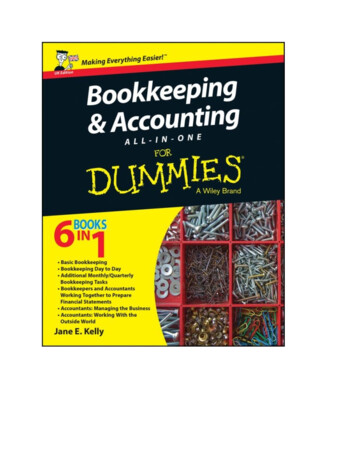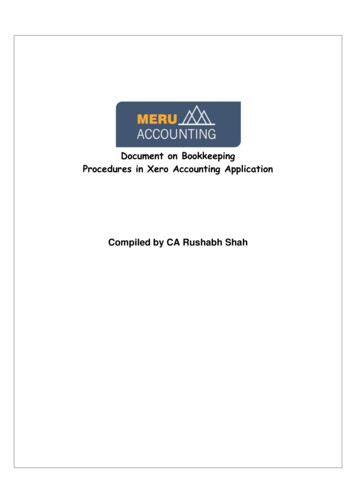
Transcription
Guide to Bookkeeping ConceptsYour AccountingCoach PRO membership includes lifetime access to all of our materials.Take a quick tour by visiting www.accountingcoach.com/quicktour.
Table of Contents (click to navigate)Introduction to bookkeepingAccountsJournalsLedgersDebits and creditsDouble-entry bookkeepingTrial balanceBookkeeping equationAccrual method vs. cash methodAdjusting entriesAdjusting entries – accrualsAdjusting entries – deferrals/prepaymentsAdjusting entries – otherReversing entriesAccounting principlesBalance sheet (or statement of financial position)Income statementStatement of cash flowsStatement of stockholders’ equityCommon financial ratiosBank reconciliationPetty cashAccounts payableAccounts receivableInternal control334456778891011111213141516161617171818For personal use by the original purchaser only. Copyright AccountingCoach .com.2
Introduction to bookkeepingBookkeeping is involved in the recording of a company’s (or any organization’s) transactions.The preferred method of bookkeeping is the double-entry method. This means that everytransaction will have a minimum of two effects. For example, if a company borrows 10,000 from itsbank 1. An increase of 10,000 must be recorded in the company’s Cash account, and2. An increase of 10,000 must be recorded in the company’s Loans Payable account.The accounts containing the transactions are located in the company’s general ledger. A simple listof the general ledger accounts is known as the chart of accounts.Prior to inexpensive computers and software, small businesses manually recorded its transactions injournals. Next, the amounts in the journals were posted to the accounts in the general ledger. Today,software has greatly reduced the journalizing and posting. For example, when today’s software isused to prepare a sales invoice, it will automatically record the two or more effects into the generalledger accounts.The software is also able to report an enormous amount of additional information ranging from thedetail for each customer to the company’s financial statements.AccountsGeneral ledger accounts are used for sorting and storing the company’s transactions. Examplesof accounts include Cash, Account Receivable, Accounts Payable, Loans Payable, AdvertisingExpense, Commissions Expense, Interest Expense, and perhaps hundreds or thousands more. Theamounts in the company’s general ledger accounts will be used to prepare a company’s financialstatements such as its balance sheet and income statement.Within the general ledger, a corporation’s accounts are usually organized as follows: Balance sheet accounts Assets Current assets Long-term investments Property, plant and equipment Other assets Liabilities Current liabilities Noncurrent liabilities Deferred credits Stockholders’ equity Paid-in capital Retained earnings Treasury stockIncome statement accounts Operating revenues Operating expenses Nonoperating revenues and gains Nonoperating expenses and lossesFor personal use by the original purchaser only. Copyright AccountingCoach .com.3
The balance sheet accounts are known as permanent or real accounts since these accounts arenot closed at the end of the accounting year. Instead, the balances are carried forward to the nextaccounting year. (If the company had Cash of 987 at the end of the accounting year, it will begin thenext accounting year with Cash of 987.)The income statement accounts are known as temporary or nominal accounts since theseaccounts are closed at the end of the accounting year. In other words, the balances in the accountsfor revenues and expenses will not carry forward to the next accounting year. Instead, the balancesin these accounts are closed by transferring the end-of-year balances to Retained Earnings. Sincethe income statement accounts will begin each accounting year with zero balances, they will reportthe company’s year-to-date revenues and expenses.A list of all of the individual balance sheet and income statement accounts that are available forrecording transactions is the chart of accounts. The chart of accounts can be expanded as moreaccounts become necessary for improved reporting of transactions.JournalsUnder a manual system (and in many bookkeeping textbooks) transactions are first recorded injournals and from there are posted to accounts. Hence, journals were defined as books of originalentry.In manual systems, there were special journals (or day books) such as a sales journal, purchasesjournal, cash receipts journal, and cash payments journal. With bookkeeping software the need forthese special journals has been reduced or eliminated. However, the general journal is still neededin both manual and computerized systems in order to record adjusting entries and correcting entries.The following entry shows the format that is used in the general journal:DateAccount NameDebitMar. 1, 2016Interest ExpenseInterest Payable2,000Credit2,000LedgersIn addition to the general ledger (which contains general ledger accounts), manual bookkeepingsystems often had subsidiary ledgers. The details in a subsidiary ledger’s accounts should addup to the summary amounts found in the related general ledger account. Subsidiary ledgers werecommon for the following general ledger accounts: Accounts Receivable, Accounts Payable,Inventory, and Property, Plant and Equipment. When a subsidiary ledger is used, the respectivegeneral ledger account is referred to as a control account.For personal use by the original purchaser only. Copyright AccountingCoach .com.4
Debits and creditsThe words debit and credit are similar to the words used 500 years ago when double-entrybookkeeping was documented by an Italian monk. Today you should think of debit and credit asfollows: debit indicates that an amount should be entered on the left side of an accountcredit indicates that an amount should be entered on the right side of an accountIn short, debit means left, credit means right.An increase in an asset account is recorded with a debit amount. In other words, the amountshould be entered on the left side of the account. (Three examples of asset accounts are Cash,Accounts Receivable, and Equipment.)A decrease in an asset account is recorded with a credit amount. In other words, the amountshould be entered on the right side of the account.To illustrate an increase and a decrease in asset accounts let’s assume that acompany pays cash for equipment which has a cost of 20,000. The companyshould record a debit of 20,000 in its asset account Equipment (since this assetincreased) and it should record a credit of 20,000 in its asset account Cash (sincethis asset decreased).Expenses are recorded as debit amounts.When a company pays 1,000 for its monthly rent, a debit of 1,000 needs to be entered in theaccount Rent Expense (and a credit of 1,000 needs to be entered in the asset account Cash).Revenues are recorded as credit amounts.To record a cash sale of 700, the account Sales needs a credit entry of 700, and the account Cashneeds a debit entry of 700.An increase in a liability account is recorded with a credit entry. In other words, the amount willbe entered on the right side of the account. (Two examples of liability accounts are Accounts Payableand Loans Payable.)A decrease in a liability account is recorded with a debit.To illustrate an increase and decrease in liability accounts let’s assume that acompany signs a promissory note to a supplier to replace its 5,000 accountspayable. A debit of 5,000 is entered in Accounts Payable (since this liabilitydecreased) and a credit of 5,000 is recorded in Loans Payable (since this liabilityincreased).An increase in a stockholders’ equity account is recorded with a credit entry. In other words,the amount will be entered on the right side of the stockholders’ equity account. (Two examples ofstockholders’ equity accounts are Common Stock and Retained Earnings.)A decrease in a stockholders’ equity account is recorded as a debit. For example, the dividendsdeclared by a corporation will mean a debit is recorded in the Retained Earnings (and a credit toanother account).For personal use by the original purchaser only. Copyright AccountingCoach .com.5
The following is a summary of debits and credits and their effect on the general ledger accounts:Type of accountNormal BalanceTo increaseTo ditdebitStockholders' debitdebitcreditLearn more about Debits and Credits.Double-entry bookkeepingDouble-entry bookkeeping (or double-entry accounting) means that every transaction will result inentries in two (or more) accounts. A minimum of one amount will be a debit (entered on the left sideof the account) and at least one amount must be a credit (entered on the right side of the account).In other words, every transaction must have the total of the debits equal to the total of the credits.To illustrate double entry, let’s assume that a person invests 100,000 in exchange for 10,000 sharesof the common stock of a new corporation. The corporation will debit the asset account Cash for 100,000 and will credit the stockholders’ equity account Common Stock for 100,000. (We areassuming that the stock does not have a par or stated value.)For a second example, let’s assume that the company has utilized a consultant at a cost of 3,000with the amount due in 30 days. The company will debit Consulting Expense for 3,000 and willcredit Accounts Payable for 3,000.If every transaction is recorded with the debit amounts equal to the credit amounts and there are noposting or math errors, the total of all of the account balances with debit balances will be equal to thetotal of all of the account balances with credit balances.For personal use by the original purchaser only. Copyright AccountingCoach .com.6
Trial balanceThe trial balance is an internal document that lists any account in the general ledger which has abalance. If an account has a debit balance, the balance is entered in the column that is headed“debit.” If an account has a credit balance, the balance is entered in the column that is headed“credit.” Each column is summed and the total of the debit column should be equal to the total of thecredit column. If the totals are identical, we say that the trial balance is “in balance.”When bookkeeping was done manually there were usually errors in writing, posting, and tabulatingamounts and balances. Hence, the trial balance was routinely prepared in order to detect and correctthe incorrect account balances. However, today’s software is written/coded to prevent such errorsfrom occurring. As a result, it is usually assumed that a trial balance from a reliable computerizedsystem is in balance.Note: Even if the trial balance is in balance (the total of the debit balances is equal to the total of thecredit balances) it does not guarantee that the general ledger is error free. For example, if an entrywas completely omitted, the total of the two columns will still be equal. The same holds true if anentry was recorded twice. The trial balance will also be in balance if an incorrect account was debited(or if an incorrect account was credited).Bookkeeping equationThe bookkeeping equation (or accounting equation) for a corporation is:Assets Liabilities Stockholders’ EquityThis equation must always be in balance under the double-entry bookkeeping method.The bookkeeping equation is also helpful in understanding debits and credits. For example, assetaccounts normally have debit balances (and assets are increased with a debit entry). Recall that theterm debit means the left side of an account. As you look at the bookkeeping equation you see thatassets are also on the left side of the equal sign.Note that liabilities are on the right side of the bookkeeping equation. Recall that earlier we saidthat liability accounts normally have credit balances (balances on the right side of the account).Stockholders’ equity accounts are on the right side of the bookkeeping equation and theseaccounts will also have credit balances.Since the stockholders’ equity account Retained Earnings will normally have a credit balance it islogical that: revenues will have credit balances since revenues will cause Retained Earnings (andtherefore stockholders’ equity) to increase, andexpenses will have debit balances since expenses cause Retained Earnings (andstockholders’ equity) to decrease.For personal use by the original purchaser only. Copyright AccountingCoach .com.7
Your understanding of bookkeeping will be enhanced if you keep in mind that: revenues cause stockholders’ equity to increase, andexpenses cause stockholders’ equity to decrease.In effect the income statement is providing details on how the corporation’s operations had causedstockholders’ equity to change. (There are also other transactions that will cause stockholders’ equityto change such as issuing additional shares of stock, declaring dividends, and other transactions.)Learn more about Accounting Equation.Accrual method vs. cash methodThe accrual method is the best bookkeeping or accounting method for: measuring a company’s net income for any accounting period, andfor the complete reporting of assets, liabilities, and stockholders’ equity.The reasons that the accrual method is better than the cash method are: revenues and the related assets will be reported when they are earned (and not when thecash is received), andexpenses and the related liabilities will be reported when the expenses actually occur (andnot when the cash is paid).Hence, the accrual method results in more complete and accurate income statements and balancesheets.[The cash method is simple, but is not effective in reporting accurately a company’s net income for aperiod of time or the financial position as of a specified date. In the U.S. there may be some inc
01.03.2016 · When bookkeeping was done manually there were usually errors in writing, posting, and tabulating amounts and balances. Hence, the trial balance was routinely prepared in order to detect and correct the incorrect account balances. However, today’s software is written/coded to prevent such errors from occurring. As a result, it is usually assumed that a trial balance from a reliable .
